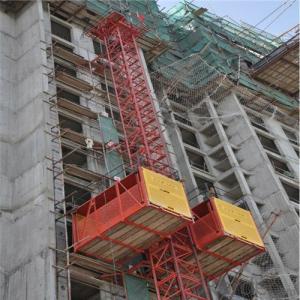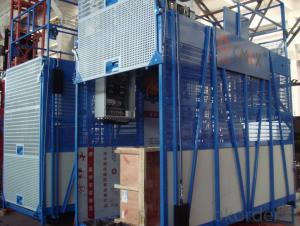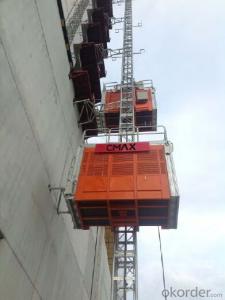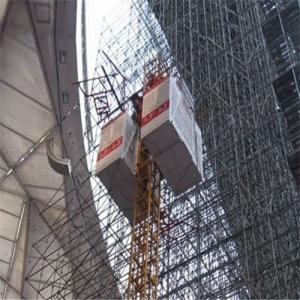SC 100/100 Building Hoist in China
- Loading Port:
- China Main Port
- Payment Terms:
- TT or LC
- Min Order Qty:
- 1 Set set
- Supply Capability:
- 100 Sets per Year set/month
OKorder Service Pledge
OKorder Financial Service
You Might Also Like
Detailed Product Description of China SC 100/100 Building Hoist
1Rated load:1000/1000kg
2lift passenger:12/12
3lift speed:0~36m/min
4without counter weight
Specification of of China SC 100/100 Building Hoist
Model | SC100 | SC100/100 | SC200/200 |
Height (m) | 12 | 12 | 50 |
Rated Loading Capacity (kg) | 1000 | 1000/1000 | 2000/2000 |
Rated Lifting Speed (m/min) | 36 | 36 | 36 |
Rated Passenger Number | 12 | 12/12 | 24/24 |
Motor Power (kw) | 2*11 | 2*2*11 | 2*3*11 |
Inner Dimension of Cage (m) | 3*1.3*2.5 | 3*1.5*2.5 | 3*1.5*2.5 |
Cage Weight (kg) | 1400 | 1400 | 1400 |
Mast Section Weight (kg) | 163 | 163 | 163 |
Mast Section Dimension (mm) | 650*650*1508 | 650*650*1508 | 650*650*1508 |
Rated Hanger Lifting Capacity (kg) | 180 | 180 | 180 |
Bottom Outline Dimension (mm) | 3100*4200 | 3100*4200 | 3100*4200 |
Numbers of Containers Needed for Shipment | One 20GP | One 40HQ | One 40HQ+One 20GP |
- Q: This question asks whether a building hoist can be utilized in both indoor and outdoor environments for lifting objects.
- <p>Yes, a building hoist can be used both indoors and outdoors for lifting objects. These hoists are designed to handle heavy materials and are often used in construction settings. However, their use is subject to specific conditions and safety requirements. Outdoor use may require additional considerations such as weatherproofing and stability in various weather conditions, while indoor use must adhere to space limitations and structural integrity of the building. Always ensure that the hoist is suitable for the environment and that all safety protocols are followed to prevent accidents.</p>
- Q: Why is the construction elevator open on one side and the other on the other
- Double door is feeding door, double door to the outside of the other's role is to prevent someone broke into the cage after elevator start circle accident, because outside over the door of the cage has a travel switch, when someone will ring into the cage opened the cage door, travel switch action at this moment, the elevator power cuts, you won't get elevator lay down this kind of thing. The door is open only when the lift is off the ground, as is said upstairs.
- Q: What are the alternative uses of a building hoist besides construction?
- <p>Yes, building hoists can be used for other purposes beyond construction. They can be utilized in various industries for material handling, such as in warehouses for moving goods, in factories for lifting machinery, and in maintenance for accessing high areas. Additionally, building hoists can be employed in emergency services for rescue operations, especially in high-rise buildings. They are also used in special events for setting up stages and equipment. The versatility of building hoists makes them a valuable tool in many different scenarios where vertical transportation of materials or personnel is required.</p>
- Q: What are the pros and cons of utilizing hydraulic fluid within the system of a building hoist?
- <p>The advantages of using hydraulic fluid in a building hoist include smooth and controlled lifting, which reduces the risk of accidents. It also offers a compact design due to the high power-to-weight ratio of hydraulic systems. Additionally, hydraulic systems are known for their durability and low maintenance requirements. However, there are disadvantages such as the potential for leaks, which can be hazardous and costly to repair. The systems can also be sensitive to temperature changes, which might affect performance. Lastly, hydraulic fluids can be environmentally harmful if not properly managed, posing disposal challenges.</p>
- Q: A building hoist is a piece of equipment used in construction to lift materials and personnel.
- <p>A building hoist, also known as a construction hoist or material hoist, is a temporary lifting device used in the construction industry to transport materials, equipment, and sometimes personnel vertically within a building under construction. It is essential for efficient movement of heavy and bulky items, reducing manual labor and improving safety by minimizing the need for workers to climb ladders or handle heavy loads manually. These hoists are typically installed on the exterior of the building and are used throughout the construction process until the building's permanent elevators are installed and operational.</p>
- Q: Is it feasible to repair or replace a building hoist with ease?
- <p>The ease of repairing or replacing a building hoist depends on several factors. For minor issues, repairs can often be done relatively easily by trained technicians. However, for major malfunctions or when a hoist is outdated, replacement might be necessary. This process can be complex and requires expertise to ensure safety and compliance with building codes. Factors such as the hoist's age, the complexity of the system, and the availability of replacement parts play a significant role in determining the ease of repair or replacement. In some cases, it might be more cost-effective to replace rather than repair, especially if the hoist is old or if repair costs are high.</p>
- Q: This question asks for a comparison between two types of building hoists: those that are electric and those that use electric motors. It seeks to understand the key distinctions between these two systems.
- <p>Electric building hoists are powered directly by electricity and typically use simpler electric motors for lifting and lowering loads. They are generally easier to install and operate, with direct control over the motor speed and direction. On the other hand, electric-motor building hoists are more complex, often incorporating advanced motor technologies and control systems. These hoists may offer features like variable speed control, energy efficiency, and smoother operation. The main differences lie in the sophistication of the motor and control systems, with electric-motor hoists often providing more precise control and better performance for heavy-duty applications.</p>
- Q: This question asks for a comparison between electric and electric-hydraulic building hoists, highlighting their distinct features and how they differ from each other.
- <p>Electric building hoists are powered solely by electric motors, which provide direct and precise control over the lifting and lowering of loads. They are quieter, require less maintenance, and are more energy-efficient compared to their hydraulic counterparts. On the other hand, electric-hydraulic building hoists combine the power of an electric motor with the force amplification capabilities of hydraulic systems. These hoists offer greater lifting capacity and can handle heavier loads but are generally more complex, requiring regular maintenance of hydraulic components. They are also louder and may consume more energy. The choice between the two often depends on the specific requirements of the lifting task, such as load capacity, precision, and environmental considerations.</p>
- Q: This question asks whether a building hoist can be utilized both indoors and outdoors and seeks an explanation for its suitability in both environments.
- <p>A building hoist can be used both indoors and outdoors, depending on the specific design and construction. Outdoor hoists are typically built to withstand weather conditions and are more robust, while indoor hoists are designed for controlled environments. The choice between indoor and outdoor use is determined by factors such as the building's structure, the materials being lifted, and the environmental conditions. Outdoor hoists may require additional features like weatherproofing and corrosion resistance, whereas indoor hoists focus on efficiency and ease of use within a protected setting.</p>
- Q: This question asks if building hoists can be utilized in both commercial and residential structures.
- <p>Yes, building hoists can be used for both commercial and residential buildings. They are essential in construction projects to efficiently transport materials and personnel vertically within the building structure. In commercial buildings, they aid in the construction of offices, retail spaces, and other similar structures. In residential buildings, they are used for constructing apartments, condominiums, and single-family homes. The choice of hoist type and capacity depends on the specific requirements of the project, such as the height of the building, the weight of materials to be transported, and the number of workers needing to be moved.</p>
1. Manufacturer Overview
| Location | Beijing,China |
| Year Established | 2003 |
| Annual Output Value | |
| Main Markets | 15.00% Eastern Europe 15.00% South America 10.00% Mid East 10.00% Western Europe 10.00% North America 5.00% Oceania 5.00% Eastern Asia 5.00% Central America 5.00% Southeast Asia 5.00% Northern Europe 5.00% Southern Europe 5.00% South Asia 5.00% Africa |
| Company Certifications | ISO9001:2000;CE |
2. Manufacturer Certificates
| a) Certification Name | |
| Range | |
| Reference | |
| Validity Period |
3. Manufacturer Capability
| a) Trade Capacity | |
| Nearest Port | 11-20 People |
| Export Percentage | 21% - 30% |
| No.of Employees in Trade Department | |
| Language Spoken: | |
| b) Factory Information | |
| Factory Size: | 10,000-30,000 square meters |
| No. of Production Lines | 5 |
| Contract Manufacturing | |
| Product Price Range | |
Send your message to us
SC 100/100 Building Hoist in China
- Loading Port:
- China Main Port
- Payment Terms:
- TT or LC
- Min Order Qty:
- 1 Set set
- Supply Capability:
- 100 Sets per Year set/month
OKorder Service Pledge
OKorder Financial Service
Similar products
Hot products
Hot Searches
Related keywords
























